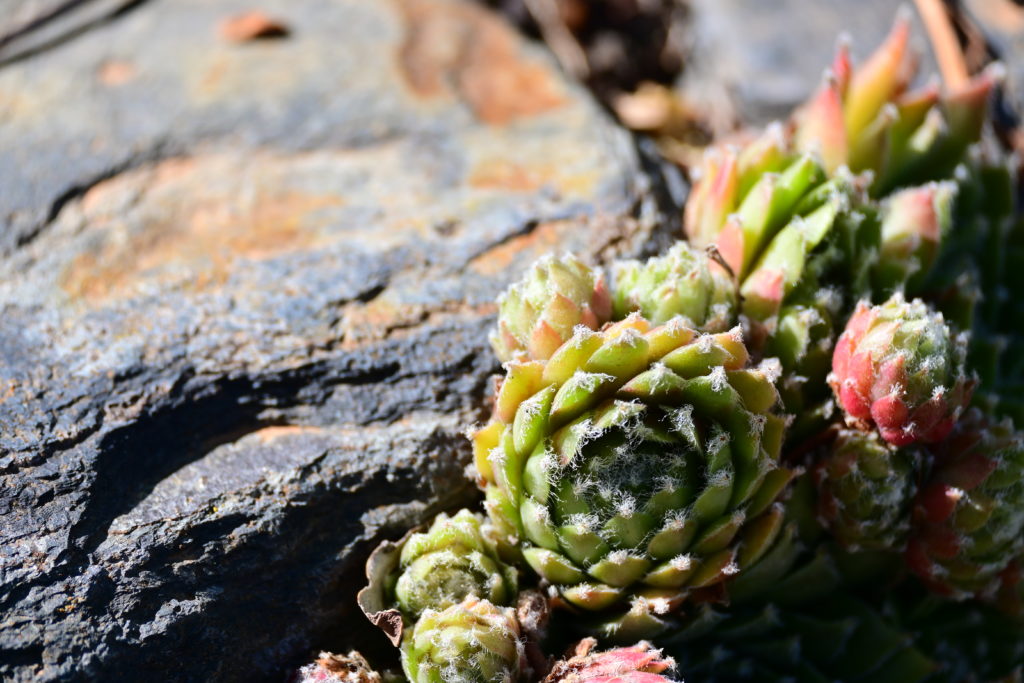When succulents are presented as a perfect solution to summer drought, rarely is there any consideration of frost tolerance. For those of us either in the hinterland or north (in Vic) or west (in other eastern states) of the Great Divide, this can be a real issue. So I'm starting a (very small) list of them. Please add to it!
Sempervivums - so far, all of them
Echeveria - these vary widely, but I've succeeded with E. glauca and E. secunda (btw, I'm not at all confident with the ID of these)
Aeonium 'Du Rozzen'. This is a complete surprise. All other Aeoniums are gelatinous after the first frost. This is indestructible. A dwarf form, and very, very dark.
Cotyledon orbiculata (but only those with a frost-hardy pedigree, such as the form (I believe) from Lambley. Others are definitely not hardy
That's it. My very short short list.
Frost-hardy succulents

Discussion
Leave a Comment
You must be logged in to post a comment.
Have grown some kalanchoe pumila from cuttings – they have survived a -2C frost. They are in a slightly raised bed. Whether they will take -5 or worse remains to be seen.
I’ve always found (formerly Sedum) Hylotelephium spectabile to be a reliably hardy. Maybe other succulents that die back to an underground rosette in winter would preform the same? It’s certainly a great characteristic for succulents to have in winter frost-prone climates. Sedum ‘Thundercloud’ seems pretty reliable in this respect too.
And another thing: the use of the word hardy to describe drought tolerance/water deficit. Urrrgh. Plant people and pedantry usually go hand in hand but this one always transcends that characteristic, to my undying frustration.
I’m with you on that ‘hardy’ thing. I grew up always thinking that it simply meant tough/robust, and then steeped myself in Northern Hem garden writing, and discovered that it’s only ever used there in regards to frost tolerance. So that’s how I’ve gone, as well.
You’re right about all the deciduous sedums. The evergreen ones, like S morganianum, which I’d love to grow, are useless
Thanks for starting the list Michael. Some I have grown:
Beschomeria yuccoides
Hesperoloe parviflora
Agave braceteosa (although unrelated to frost, they have always been a bit yellowish)
Agave geminiflora
Aloe arborescens
Some others described as tolerant to -5 or less I would like to try at some point
Agave beauleriana ‘Grey Ghost’
Agave parryi
Echinopsis spachiana
Furcraea bedinghausii (arriving from Lambley shortly…)
Aloe arborescens? Really? I don’t think I’d stand a chance here. Do you think you have a particularly drought tolerant form?
I was going to say the one from the bowling club in Bendigo on way from railway station that grows over fence invitingly and that BPG indicates -5 degrees celsius (which is the lowest I know of us getting to here) and Brian Kemble’s List of Hardy Aloes says 19F in cultivation which is -7.2C. But just acquired from Lambley an Aloe – Aloiampelos striatula (formerly Aloe striatula) described as Frost Hardy Aloe “This super frost hardy aloe makes a shrub some 150cm tall by as much wide shrub. The striated stems are well clothed with narrow dark green succulent leaves. For months during the warmer months lime green opening to coral flowers are carried well above the foliage on strong stems. Lambley has Craig Irving to thank for giving us this plant. Happy in any sunny well drained spot and drought hardy when once established.” And I think in fact the plant I acquired, having just walked down with it to compare, is the one I already had…so I am sorry have to change my answer to Aloiampelos striatula (formerly Aloe striatula).
Riddells Creek is a great place to test frost sensitive succulents! Although not as frosty as Woodend.
Many varieties of echeveria including imbricata which I wouldn’t be without.
Cotyledon macrantha and orbiculata – the Lambley upright form as well as the wavy form.
Furcraea sp.
Beschorneria yuccoides and septentrionalis
Many agaves
One enormous aloe – a ferox/arborescens cross now 3m tall!
Senecio serpens – big and little forms
Aeonium Emerald Carpet (light frosts only)
Aeonium haworthii, urbicum, canariense, Kiwi and an unnamed tall green one
Beaucarnea recurvata
Kumara plicatilis – syn Aloe plicatilis
Hylotelephium Autumn Joy, Matrona and a variegated one
Various sedums and crassulas
Hesperaloe parviflora
Echinocactus grusonii
Yucca desmettiana
I’ve got to get that Aeonium ‘Du Rozzen’ to you, don’t I…
What a great list! thank you
Greg Lyon’s wonderful ‘Wild Honey’ garden at Creswick was an exemplar of the type when it was in his hands – regrettably he has moved to a new frontier at Toowoomba. Leo Chance’s ‘Cacti and Succulents for Cold Climates’ is a great reference.
From what I understand many succulents can survive the cold temperatures better if they are dry- if they are left in the rain and the cold then they turn to mush but dry cold is more manageable. Probably not true for all of them but this certainly helps Agave attenuata, Cotyledon orbiculata and my little evergreen Sedum- the carpet forming ground cover- sorry I don’t know the botanical name!